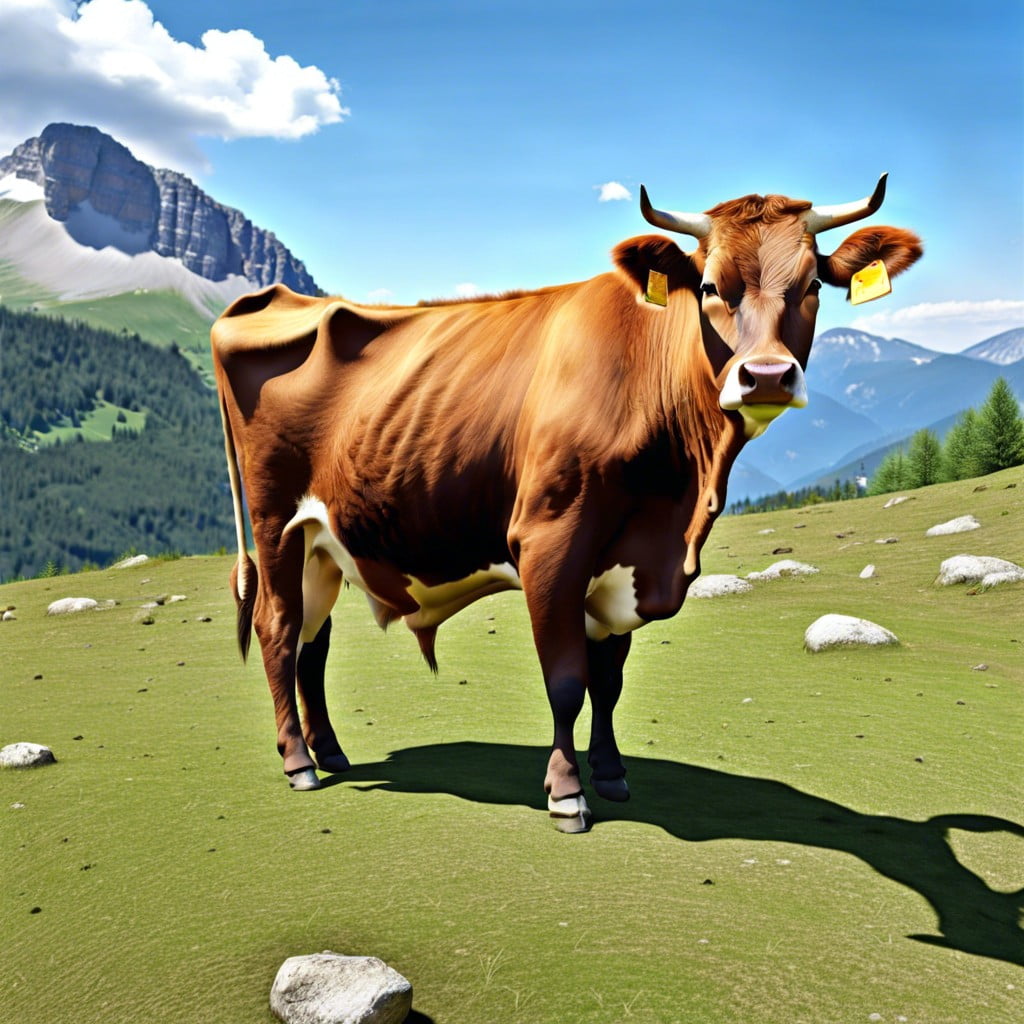Last updated on
Explore the fascinating world of mountain cows because their unique adaptation strategies to challenging habitats contribute significantly to our understanding of nature’s resilience.
Key takeaways:
- Mountain cows, also known as bison or buffalo, are large, robust animals adapted to mountainous regions.
- They reside in cold, high-altitude areas with harsh climates and are well-adapted to survive in these challenging environments.
- Mountain cows are primarily herbivorous and exhibit seasonal migration patterns to find food.
- Conservation efforts aim to protect their habitats and maintain genetic diversity.
- Mountain cows have economic and cultural significance, contributing to local economies and traditional practices.
Definition and Description of Mountain Cows

Mountain cows, commonly referred to as bison or buffalo in North America, are large, powerful animals that typify the bovine group found in mountainous regions. They are distinguished from domestic cattle by their robust bodies, broad heads, and the presence of thick fur designed to protect them from harsh climatic conditions.
These mammals exhibit a brown or dark grey coat and often have a hump on their shoulders, a trait specific to their genus. Males are typically larger than females, showcasing pronounced physical traits that highlight sexual dimorphism in the species. Their hooves are adapted to the rugged terrain of mountain environments, allowing for efficient movement across slopes and rocky surfaces.
These characteristics not only define their physical appearance but also contribute to their survival in less forgiving altitudes where temperatures can plummet and forage is seasonally scarce.
Origin and Historical Significance

The origins of mountain cows trace back to their domestic ancestors, primarily cattle that were adapted to live in rugged terrain. Through selective breeding and natural adaptation, these cows developed traits allowing them to thrive in mountainous areas.
Historical records suggest their presence alongside human settlements in high altitudes, fulfilling roles from plowing fields to providing dairy and meat. Indigenous groups and early mountain communities often revered these animals for their resilience and contribution to survival in harsh climates.
Their significance extends beyond mere utility; in many cultures, they are intertwined with tradition and folklore, symbolizing strength and endurance.
Habitat and Distribution
Mountain cows, commonly known as Domestic Yaks (Bos grunniens), thrive in the cold, mountainous regions of Central Asia. They are predominantly found on the Tibetan Plateau, including parts of China, India, Nepal, Bhutan, and Mongolia. These animals are well-adapted to high altitudes, often residing at elevations ranging from 2,000 to 5,000 meters.
The environment where they live is characterized by alpine meadows, steep mountainous terrains, and harsh climate conditions. This is due to thin air that has low oxygen levels and temperatures that can plummet below freezing even during summer nights. Despite such challenging conditions, the thick fur and a unique respiratory system of the mountain cow allow it to survive and thrive where other domesticated livestock would struggle.
Furthermore, these animals are nomadic, following a seasonal migration pattern. They move to lower elevations during the winter to escape the extreme cold and ascend to higher pastures during the summer months for grazing. This migratory behavior is crucial for their survival, helping them to access food sources that are scarce in these high-altitude environments.
Their presence across various countries in Asia is not uniform, with some areas seeing denser populations due to more favorable environmental conditions and traditional herding practices that protect their way of life. As modernization encroaches upon these regions, the distribution of the mountain cow faces adjustments, influencing both the animals and the human communities that depend on them.
Physical Characteristics and Adaptations
Adapted to rugged terrains and variable climatic conditions, these bovines possess a muscular build with sturdy legs that support their agile maneuvering on steep inclines. Their hooves are broad and hard, providing stability on loose soils and rocky surfaces.
A dense, woolly undercoat serves as insulation against harsh winters, while a longer overcoat can be shed in warmer months to regulate body temperature. The males, known for prominent horns, use them for defense and during mating season displays. Enhanced lung capacity allows for efficient oxygen consumption at high altitudes, where oxygen levels are lower. This physiological adaptation ensures survival in environments less hospitable to other livestock.
Diet and Foraging Behavior
Mountain cows display remarkable adaptability in their feeding habits to thrive in the diverse terrain they inhabit. Primarily herbivorous, these bovines forage on a variety of vegetation, such as grasses, shrubs, and tree bark.
The seasonal variation in food availability requires them to travel considerable distances in search of nutrition. They often graze at lower altitudes during warmer seasons when plant life is abundant and venture to higher elevations as snow recedes and exposes fresh growth.
The social structure of mountain cow herds also plays a role in foraging behavior, with movement patterns and feeding spots frequently determined by dominant individuals. Efficient digestion of cellulose-rich plants is facilitated by a specialized stomach, further evidence of their evolutionary adaptation.
Understanding these dietary patterns aids in the management and preservation of their natural habitats.
Breeding Practices and Genetics
Selective breeding has been a cornerstone in enhancing desirable traits in mountain cow populations, which typically include robust health, adaptability to high-altitude environments, and increased productivity in terms of milk yield and quality of meat. Genetic diversity within these herds is closely monitored to prevent inbreeding, which can lead to health issues and a decrease in vitality.
Artificial insemination is often used to introduce new genetic material from high-quality sires, contributing to genetic improvement over generations. This also allows for the preservation of specific characteristics that are unique to the mountain cow, such as thick fur for insulation and larger lungs for efficient breathing in thin mountain air.
Genetic research aids in the identification of traits linked to disease resistance and longevity. Breeding programs prioritize these traits to ensure the sustainability of herds.
Recent advances in genomics have paved the way for more precise breeding techniques. DNA testing is utilized to make informed decisions about breeding pairs, promoting genetic health while also aiming to enhance specific traits such as docility, which improves the safety of herding in rough terrain.
Overall, the combination of traditional knowledge and modern science ensures the vitality and continued presence of mountain cow populations in their native environments.
Conservation Status and Efforts
Efforts to protect mountain cows are multifaceted, focusing on preserving their natural habitats and genetic diversity. National parks and protected areas offer sanctuary from habitat destruction due to agriculture and urbanization. Breed-specific conservation programs work to maintain healthy populations through selective breeding strategies, avoiding the dilution of unique genetic traits.
Partnerships between conservation organizations, governments, and local communities are crucial. These collaborations help balance the needs of wildlife with those of people living in mountainous regions. Educational campaigns aim to increase awareness about the importance of mountain cows to biodiversity and ecosystem health.
Relocation and rewilding projects occasionally move individuals to new areas to reduce pressure on overgrazed habitats and create more stable populations. Moreover, monitoring through tracking collars and regular population surveys helps assess the effectiveness of conservation strategies and adjust them as needed.
Role in Local Economies and Cultural Significance
Mountain cows contribute significantly to the economies of the regions they inhabit, serving as both a source of livelihood and a cultural cornerstone. In agriculture, these animals are prized for their strength and endurance, often used for plowing fields and transporting goods across difficult terrains. They provide essential products such as milk, meat, and leather, contributing to the food supply and local craft industries.
Beyond economic value, these bovines hold a place in the heart of traditional folklore and ceremonies. In some cultures, they are revered and featured in festivals, symbolizing strength and resilience. Their presence in art and stories underscores their importance in the cultural tapestry of mountain communities.
Furthermore, eco-tourism initiatives increasingly recognize the appeal of these animals, attracting visitors keen on experiencing rural lifestyles and traditional practices involving the mountain cow. This not only boosts local revenue but also fosters a deeper appreciation for the cultural heritage associated with these creatures.
Challenges Facing Mountain Cow Populations
Climate change poses a significant threat to mountain cow populations. Altered weather patterns can lead to habitat degradation, affecting the availability of food and water. Additionally, increased temperatures and unpredictable snowfalls disrupt traditional migration and breeding cycles.
Human activities, such as agriculture and urbanization, also encroach upon natural habitats. Loss of grazing land to farming and infrastructure development forces these animals into smaller, fragmented areas, which can lead to overgrazing and increased competition for resources.
Diseases and parasites present another challenge, particularly as interactions with domestic cattle can lead to cross-species transmission. This exchange of pathogens can result in outbreaks that may devastate populations lacking resistance to certain illnesses.
Predation pressure can affect survival rates, especially for calves. Natural predators are essential for maintaining healthy ecosystems, but an imbalance, often due to human-induced changes, can lead to higher predation rates than usual.
Finally, genetic diversity can be compromised through isolation and small population size, making mountain cows more vulnerable to diseases and reducing their ability to adapt to environmental changes. Preservation of genetic variability is critical for the resilience and long-term survival of the species.
Future Outlook and Research Directions
The future of mountain cows hinges on the successful balance between conservation efforts and the needs of local communities. Research is increasingly focused on genetic studies to understand the adaptability and resilience of these animals in changing climates.
Scientists are also exploring sustainable farming practices that can protect both the species and the livelihoods of those who depend on them. Another critical area is the impact of tourism, with initiatives aimed at ensuring that any increase in human activity does not disrupt their natural habitats.
Technologies like GPS tracking and AI-powered monitoring systems are gaining traction for real-time data collection, allowing for proactive rather than reactive management strategies. Lastly, the integration of traditional knowledge with modern science is recognized as a valuable approach to ensuring the longevity and health of mountain cow populations around the globe.




